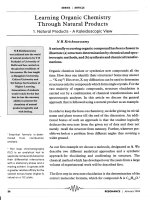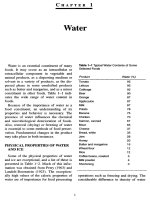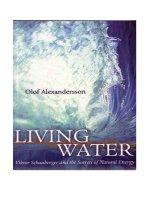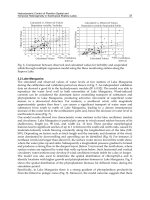Natural water chemistry
Bạn đang xem bản rút gọn của tài liệu. Xem và tải ngay bản đầy đủ của tài liệu tại đây (5.59 MB, 43 trang )
Natural
Water
Chemistry
Water Quality Parameters
Temperature - Dissolved Oxygen (DO) - pH
Alkalinity - Hardness
Nitrates and Phosphates - Turbidity
Conductivity
-
Temperature
Affects:
Water density
Gas solubility
Chemical reaction rates
Organism growth rates
Conductivity
pH
Dissolved Oxygen
Temperature – naturally varies
because of…
… Changes in seasonal/diurnal air
temperature
… Thermal stratification in lakes
… Size and temperature of inflows
… Residence time (lakes)
Temperature – artificially varies
because of…
… Heated industrial effluent
… Runoff from asphalt/pavement
… Deforestation
Q10 rule
cold-blooded aquatic organisms
Predicts that growth rate will double
if temperature increases by 10˚C
(18˚F) within their "preferred" range.
Dissolved Oxygen (DO)
DO is the measurement of oxygen
dissolved in water and available for
fish and other aquatic life.
Indicates health of an aquatic system.
Can range from 0-18 ppm.
Most natural water systems require 56 ppm to support a diverse population.
Varies with time of day, weather, temperature.
Dissolved Oxygen (DO)
Increase in organic waste
Increase in algae/plant vegetation
Decrease in DO available to organisms
Leads to changes in ecosystem as
organisms needing lots of DO are
replaced by organisms needing little.
Hood Canal, Wash. DO
Hood
Canal
Sill
Saltwater from entry
point.
Freshwater from stream
and river runoff.
Highly stratified
Slow-circulating
Long residence time
Hood Canal
Jan
Apr
Jun
Sept
Dec
Modified from Hood Canal Dissolved Oxygen Project, Collias, UW, PRISM 2005
/>
Potential causes
Natural
•
•
•
•
•
increased sunlight or other climate factors
increased nutrient availability
Changes in ocean properties
Changes in river input (e.g.: drought)
Changes in weather conditions
Artificial
•
•
human loading of nutrients or organic material
Changes in river input (eg: diversion)
pH - p(otential of) H(ydrogen)
Determines the solubility of nutrients (PO 4-3, NO3-, C)
and heavy metals (Fe, Cu, etc)
Determines availability of these chemicals for use by aquatic life.
In natural water systems, determined largely by geology and soils.
pH of natural waters
Sea water
due to humic acid
Limestone, marble, CO3 rich
Pure rain, snow
Modified from www.waterwatch.org
/>
Factors that affect pH
• Algal blooms
• Bacterial activity
• Water turbulence
• Chemicals flowing into the water body
• Sewage overflows
• Pollution
How pH affects aquatic life
Decreasing pH
(e.g.: via acid rain)
▼
Liberation of Al, metals
▼
Toxic conditions
▼
Chronic stress
▼
Smaller, weaker fish
Alkalinity
Alkalinity refers to the capability of water to neutralize acid.
Buffering capacity –
resistance to pH changes.
Common natural buffer: CO3
(carbonates – like
limestone).
Protects aquatic life.
Commonly linked to water
hardness.
Limestone outcrop
In natural systems:
50 – 150 mg/L as CaCO3.
Hardness
Reflects dissolved
carbonate minerals.
Mostly of concern for
drinking water
standards.
Metals precipitate out
of solution.
Create scale/hard
water deposits
High alkalinity
Hard water
From USGS
/>
and
Nitrate (NO3-)
naturally-occurring
form of nitrogen
found in soil.
Forms by microbial
decomposition of
fertilizers, plants,
manures or other
organic residues
Plants uptake
nitrates (Spinach a
good source).
Phosphate (PO4-3)
naturally occurs in
rocks and minerals.
Plants uptake
weathered-out
elements and
compounds.
Animals ingest plants.
Water soluble.
Redfield Ratio: 106:16:1
Nitrates
Artificial sources:
• Livestock
manure/urine
• Failing septic
systems
• Synthetic fertilizers
Can lead to:
eutrophication of natural
water systems
(overproduction of
vegetation)
Blue baby syndromne
The U.S. EPA has set a maximum
contaminant level for NO3- in drinking
water of 10 parts per million (ppm)
Phosphates
Artificial sources:
• Sewage
• Laundry,
cleaning fluids
• Synthetic
fertilizers
Can also lead to
eutrophication of
natural water
systems
(overproduction of
vegetation)
Blue green algae
1990 and 1999 comparison
of Nitrates in Great Lakes
From US EPA
/>









